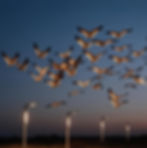
The Benefits of LED Lights for Migratory Birds
Apr 29
2 min read
0
57
0
Migratory birds use natural cues, such as the positions of the stars and the moon, to navigate their long-distance flights. Artificial lighting, particularly excessive nocturnal illumination, might alter their movement patterns, resulting in disorientation and higher fatality rates from accidents with buildings (Rich and Longcore, 2006). While artificial light pollution is a substantial hazard, LED lighting presents a viable approach for mitigating these risks.

Traditional lighting, such as incandescent and fluorescent bulbs, often emits excessive and scattered light, contributing to skyglow and attracting birds into urban areas where they face dangers like glass collisions (Rodríguez et al., 2017). LED lights, on the other hand, give directional lighting and can be designed to minimise unnecessary light spill, reducing the impact on nocturnal migratory birds. Shielded LED fixtures direct light downward, preventing it from scattering into the sky and confusing birds (Montevecchi, 2006).

Additionally, LED technology allows for precise control over light intensity and wavelength. Studies suggest that certain wavelengths, particularly red and amber lights, are less disruptive to birds compared to blue and white lights. Research has shown that blue light attracts nocturnally migrating birds, thereby increasing their risk of collision, whereas red light has a significantly lower impact on their navigation (Poot et al., 2008). Cities and businesses can create safer habitats for migrating birds by altering the colour spectrum of outdoor lights while preserving the essential illumination for human activity.
In addition to their environmental benefits, LED lights are significantly more energy-efficient than traditional bulbs. They consume less electricity, reducing carbon emissions and contributing to a more sustainable environment. Since climate change also affects migratory bird populations, adopting energy-efficient lighting solutions indirectly supports conservation efforts (Gaston et al., 2013).
By implementing LED lighting solutions with bird-friendly designs, cities and communities can help protect migratory birds while benefiting from energy efficiency and sustainability. As research continues to advance, LED technology remains a crucial tool in balancing human needs with wildlife conservation.
For a free lighting evaluation and to improve your building's ecological impact, get in contact today! Email: Michael.constantinou@b-enggroup.co.uk
Phone: 07399113788
References
Gaston, K. J., Bennie, J., Davies, T. W., & Hopkins, J. (2013). 'The ecological impacts of nighttime light pollution: A review of current knowledge'. Biological Conservation, 167, pp. 1-9.
Montevecchi, W. A. (2006). 'Influences of artificial light on marine birds'. Marine Ornithology, 34(2), pp. 167-179.
Poot, H., Ens, B. J., De Vries, H., Donners, M. A. H., & Marquenie, J. M. (2008). 'Green light for nocturnally migrating birds'. Ecology and Society, 13(2), pp. 47.
Rich, C., & Longcore, T. (2006). Ecological Consequences of Artificial Night Lighting. Washington, D.C.: Island Press.
Rodríguez, A., Burgos, R., & Jovani, R. (2017). 'Artificial lights and seabird mortality'. Scientific Reports, 7(1), pp. 14567.
Van Doren, B. M., Horton, K. G., Dokter, A. M., Klinck, H., Elbin, S. B., & Farnsworth, A. (2017). 'High-intensity urban light installation dramatically alters nocturnal bird migration'. Proceedings of the National Academy of Sciences,
Wang, Y., Xu, H., Alur, S., Sharma, Y., Cheng, A. J., Kang, K., Josefsberg, R., Park, M., Sakhawat, S., Guha, A. N., Akpa, O., Akavaram, S., & Das, K. (2010). In Situ Temperature Measurement of GaN-Based Ultraviolet Light-Emitting Diodes by Micro-Raman Spectroscopy. Journal of Electronic Materials. https://doi.org/10.1007/s11664-010-1360-8









